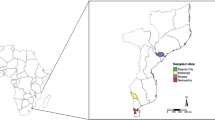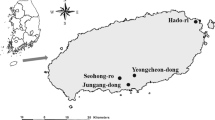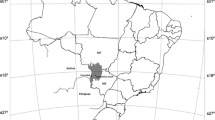Abstract
Cattle do not generally appear to develop severe viremia when infected with Japanese encephalitis virus (JEV), and they can be infected without showing clinical signs. However, two cattle in Japan recently died from JEV infection. In this study, we investigated the presence of different species of mosquitoes and flavivirus in a cowshed in the southwest region of Japan. In this cowshed, the two most common species of mosquitoes collected were Culex tritaeniorhynchus (including Culex pseudovishnui) and Anopheles sinensis. We performed virus isolation from the collected mosquitoes and obtained two flaviviruses: JEV and a novel insect-specific flavivirus, tentatively designated Yamadai flavivirus (YDFV). Phylogenetic analysis revealed that all three JEV isolates belonged to JEV genotype I and were closely related to a JEV strain that was isolated from the brains of cattle exhibiting neurological symptoms in Japan. Genetic characterization of YDFV revealed that the full genome RNA (10,863 nucleotides) showed homology with the Culex-associated insect-specific flaviviruses Quang Binh virus (79 % identity) and Yunnan Culex flavivirus (78 % identity), indicating that YDFV is a novel insect-specific flavivirus.




Similar content being viewed by others
References
Lindenbach BD, Murray CL, Thiel HJ, Rice CM (2013) Flaviviridae. In: Knipe DM, Howley PM (eds) Fields virology, 6th edn. Lippincott Williams and Wilkins, Philadelphia, pp 712–746
Misra UK, Kalita J (2010) Overview: Japanese encephalitis. Prog Neurobiol 91:108–120
Schuh AJ, Ward MJ, Leigh Brown AJ, Barrett AD (2014) Dynamics of the emergence and establishment of a newly dominant genotype of Japanese encephalitis virus throughout Asia. J Virol 88:4522–4532
Nabeshima T, Morita K (2010) Phylogeographic analysis of the migration of Japanese encephalitis virus in Asia. Future Virol 5:343–351
Philip SP, Hiriyan J, Gajanana A (2000) Japanese encephalitis virus infection in mosquitoes and its epidemiological implications. ICMR Bull 30:37–43
Clements AN (1999) Mosquito-host interaction. In: Clements AN (ed) The biology of mosquitoes: sensory reception and behaviour. CABI Press, UK, pp 480–550
Ilkal MA, Dhanda V, Rao BU, George S, Mishra AC, Prasanna Y, Gopalkrishna S, Pavri KM (1988) Absence of viraemia in cattle after experimental infection with Japanese encephalitis virus. Trans R Soc Trop Med Hyg 82:628–631
Sakai T, Horimoto M (1989) Japanese encephalitis virus infection in cattle: changes in antibody distribution in the central district of Japan during a 4-year period. Prev Vet Med 116:325–335
Katayama T, Saito S, Horiuchi S, Maruta T, Kato T, Yanase T, Yamakawa M, Shirafuji H (2013) Nonsuppurative encephalomyelitis in a calf in Japan and isolation of Japanese encephalitis virus genotype 1 from the affected calf. J Clin Microbiol 51:3448–3453
Kato N, Suzuki S, Sugie N, Kato T, Yanase T, Yamakawa M, Shirafuji H (2014) Japanese encephalitis in a 114-month-old cow: pathological investigation of the affected cow and genetic characterization of Japanese encephalitis virus isolate. BMC Vet Res 10:63
Lim SI, Kweon CH, Tark DS, Kim SH, Yang DK (2007) Sero-survey on Aino, Akabane, Chuzan, bovine ephemeral fever and Japanese encephalitis virus of cattle and swine in Korea. J Vet Sci 8:45–49
Cook S, Moureau G, Kitchen A, Gould EA, de Lamballerie X, Holmes EC, Harbach RE (2012) Molecular evolution of the insect-specific flaviviruses. J Gen Virol 93:223–234
Lutomiah JJ, Mwandawiro C, Magambo J, Sang RC (2007) Infection and vertical transmission of Kamiti river virus in laboratory bred Aedes aegypti mosquitoes. J Insect Sci 7:1–7
Saiyasombat R, Bolling BG, Brault AC, Bartholomay LC, Blitvich BJ (2011) Evidence of efficient transovarial transmission of Culex flavivirus by Culex pipiens (Diptera: Culicidae). J Med Entomol 48:1031–1038
Bolling BG, Olea-Popelka FJ, Eisen L, Moore CG, Blair CD (2012) Transmission dynamics of an insect-specific flavivirus in a naturally infected Culex pipiens laboratory colony and effects of co-infection on vector competence for West Nile virus. Virology 427:90–97
Hoshino K, Isawa H, Tsuda Y, Yano K, Sasaki T, Yuda M, Takasaki T, Kobayashi M, Sawabe K (2007) Genetic characterization of a new insect flavivirus isolated from Culex pipiens mosquito in Japan. Virology 359:405–414
Morales-Betoulle ME, Monzón Pineda ML, Sosa SM, Panella N, López MR, Cordón-Rosales C, Komar N, Powers A, Johnson BW (2008) Culex flavivirus isolates from mosquitoes in Guatemala. J Med Entomol 45:1187–1190
Blitvich BJ, Lin M, Dorman KS, Soto V, Hovav E, Tucker BJ, Staley M, Platt KB, Bartholomay LC (2009) Genomic sequence and phylogenetic analysis of Culex flavivirus, an insect-specific flavivirus, isolated from Culex pipiens (Diptera: Culicidae) in Iowa. J Med Entomol 46:934–941
Cook S, Moureau G, Harbach RE, Mukwaya L, Goodger K, Ssenfuka F, Gould E, Holmes EC, de Lamballerie X (2009) Isolation of a novel species of flavivirus and a new strain of Culex flavivirus (Flaviviridae) from a natural mosquito population in Uganda. J Gen Virol 90:2669–2678
Kim DY, Guzman H, Bueno R Jr, Dennett JA, Auguste AJ, Carrington CV, Popov VL, Weaver SC, Beasley DW, Tesh RB (2009) Characterization of Culex Flavivirus (Flaviviridae) strains isolated from mosquitoes in the United States and Trinidad. Virology 386:154–159
Farfan-Ale JA, Loroño-Pino MA, Garcia-Rejon JE, Soto V, Lin M, Staley M, Dorman KS, Bartholomay LC, Hovav E, Blitvich BJ (2010) Detection of flaviviruses and orthobunyaviruses in mosquitoes in the Yucatan Peninsula of Mexico in 2008. Vector Borne Zoonotic Dis 10:777–783
Saiyasombat R, Dorman KS, Garcia-Rejon JE, Loroño-Pino MA, Farfan-Ale JA, Blitvich BJ (2010) Isolation and sequence analysis of Culex flavivirus from Culex interrogator and Culex quinquefasciatus in the Yucatan Peninsula of Mexico. Arch Virol 155:983–986
Bolling BG, Eisen L, Moore CG, Blair CD (2011) Insect-specific flaviviruses from Culex mosquitoes in Colorado, with evidence of vertical transmission. Am J Trop Med Hyg 85:169–177
Machado DC, Mondini A, dos Santos Santana V, Yonamine PT, Chiaravalloti Neto F, Zanotto PM, Nogueira ML (2012) First identification of Culex flavivirus (Flaviviridae) in Brazil. Intervirology 55:475–483
Goenaga S, Fabbri CM, García JB, Rondán JC, Gardenal N, Calderón GE, Enria DA, Levis SM (2014) New strains of Culex flavivirus isolated in Argentina. J Med Entomol 51:900–906
Obara-Nagoya M, Yamauchi T, Watanabe M, Hasegawa S, Iwai-Itamochi M, Horimoto E, Takizawa T, Takashima I, Kariwa H (2013) Ecological and genetic analyses of the complete genomes of Culex flavivirus strains isolated from Culex tritaeniorhynchus and Culex pipiens (Diptera: Culicidae) group mosquitoes. J Med Entomol 50:300–309
Crabtree MB, Nga PT, Miller BR (2009) Isolation and characterization of a new mosquito flavivirus, Quang Binh virus, from Vietnam. Arch Virol 154:857–860
Zuo S, Zhao Q, Guo X, Zhou H, Cao W, Zhang J (2014) Detection of Quang Binh virus from mosquitoes in China. Virus Res 180:31–38
Parreira R, Cook S, Lopes Â, de Matos AP, de Almeida AP, Piedade J, Esteves A (2012) Genetic characterization of an insect-specific flavivirus isolated from Culex theileri mosquitoes collected in southern Portugal. Virus Res 167:152–161
Kuno G, Chang GJ, Tsuchiya KR, Karabatsos N, Cropp CB (1998) Phylogeny of the genus Flavivirus. J Virol 72:73–83
Yun SI, Kim SY, Rice CM, Lee YM (2003) Development and application of a reverse genetics system for Japanese encephalitis virus. J Virol 77:6450–6465
Larkin MA, Blackshields G, Brown NP, Chenna R, McGettigan PA, McWilliam H, Valentin F, Wallace IM, Wilm A, Lopez R et al (2007) Clustal W and Clustal X version 2.0. Bioinformatics 23:2947–2948
Jones DT, Taylor WR, Thornton JM (1992) The rapid generation of mutation data matrices from protein sequences. Comput Appl Biosci 8:275–282
Kimura M (1982) A simple method for estimating evolutionary rates of base substitutions through comparative studies of nucleotide sequences. J Mol Evo 16:111–120
Felsenstein J (2005) PHYLIP (Phylogeny Inference Package) version 3.6. http://evolution.genetics.washington.edu/phylip.html. Accessed 10 April 2013
Felsenstein J (1985) Confidence-limits on phylogenies—an approach using the bootstrap. Evolution 39:783–791
Takhampunya R, Kim HC, Tippayachai B, Kengluecha A, Klein TA, Lee WJ, Grieco J, Evans BP (2011) Emergence of Japanese encephalitis virus genotype V in the Republic of Korea. Virol J 8:449
Obara M, Yamauchi T, Watanabe M, Hasegawa S, Ueda Y, Matsuno K, Iwai M, Horimoto E, Kurata T, Takizawa T et al (2011) Continuity and change of Japanese encephalitis virus in Toyama Prefecture, Japan. Am J Trop Med Hyg 84:695–708
Takasaki T, Kotaki A, Kurane I, Sawabe K, Hayashi T, Kobayashi M (2009) Isolation of Japanese encephalitis virus from wild boar captured in winter season. IASR 30:156–157 (in Japanese)
Ohno Y, Sato H, Suzuki K, Yokoyama M, Uni S, Shibasaki T, Sashika M, Inokuma H, Kai K, Maeda K (2009) Detection of antibodies against Japanese encephalitis virus in raccoons, raccoon dogs and wild boars in Japan. J Vet Med Sci 71:1035–1039
Shimoda H, Ohno Y, Mochizuki M, Iwata H, Okuda M, Maeda K (2010) Dogs as sentinels for human infection with Japanese encephalitis virus. Emerg Infect Dis 16:1137–1139
Liu XB, Liu QY, Guo YH, Jiang JY, Ren DS, Zhou GC, Zheng CJ, Zhang Y, Liu JL, Li ZF et al (2011) The abundance and host-seeking behavior of culicine species (Diptera: Culicidae) and Anopheles sinensis in Yongcheng city, People’s Republic of China. Parasit Vectors 4:221
Thenmozhi V, Rajendran R, Ayanar K, Manavalan R, Tyagi BK (2006) Long-term study of Japanese encephalitis virus infection in Anopheles subpictus in Cuddalore district, Tamil Nadu, South India. Trop Med Int Health 11:288–293
Feng Y, Fu S, Zhang H, Li M, Zhou T, Wang J, Zhang Y, Wang H, Tang Q, Liang G (2012) Distribution of mosquitoes and mosquito-borne viruses along the China-Myanmar border in Yunnan Province. Jpn J Infect Dis 65:215–221
Liu H, Lu HJ, Liu ZJ, Jing J, Ren JQ, Liu YY, Lu F, Jin NY (2013) Japanese encephalitis virus in mosquitoes and swine in Yunnan province, China 2009–2010. Vector Borne Zoonotic Dis 13:41–49
Kamimura K (1968) The distribution and habit of medically important mosquitoes of Japan. Med Entomol Zool 19:15–34 (in Japanese)
Naik PS, Ilkal MA, Pant U, Kulkarni SM, Dhanda V (1990) Isolation of Japanese encephalitis virus from Culex pseudovishnui Colless, 1957 (Diptera: Culicidae) in Goa. Indian J Med Res 91:331–333
Mourya DT, Mishra AC, Soman RS (1991) Transmission of Japanese encephalitis virus in Culex pseudovishnui & C. tritaeniorhynchus mosquitoes. Indian J Med Res 93:250–252
Wada Y, Watanabe M (1971) Ecological studies of Culex tritaeniorhynchus summorosus (Diptera: Culicidae): IV. Comparative studies on the behavior of C. tritaeniorhynchus summorosus and C. pseudovishnui. Med Entomol Zool 22:24–30 (in Japanese)
Acknowledgments
The authors would like to thank Norio Kamura and the staff of the Experimental Farm of Yamaguchi University for their assistance in arranging field work. This work was supported in part by a grant from the Ministry of Education, Culture, Sports, Science and Technology TOKUBETSUKEIHI to Dr. Masahiro Fujishima, Yamaguchi University, and Grants-in-Aid from the Japanese Ministry of Health, Labor and Welfare (H25-Shinko-Ippan-006), and the Japan Society for the Promotion of Science (KAKEN Grant No. 25893151).
Author information
Authors and Affiliations
Corresponding author
Electronic supplementary material
Below is the link to the electronic supplementary material.
Rights and permissions
About this article
Cite this article
Kuwata, R., Sugiyama, H., Yonemitsu, K. et al. Isolation of Japanese encephalitis virus and a novel insect-specific flavivirus from mosquitoes collected in a cowshed in Japan. Arch Virol 160, 2151–2159 (2015). https://doi.org/10.1007/s00705-015-2488-x
Received:
Accepted:
Published:
Issue Date:
DOI: https://doi.org/10.1007/s00705-015-2488-x




